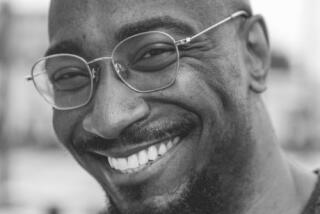A portrait of the writer as wreck in â& Sonsâ
The fictional writer A.N. Dyer â Andrew to his family â is dying as David Gilbertâs new novel â& Sonsâ opens. Dyer is a New York writer in the mold of J.D. Salinger: When he was in his 20s, he wrote a book about his New England prep school, a novel whose portrait of teenage angst and white privilege was a success rivaling that of âThe Catcher in the Rye.â
Dyer is âthe quintessential New York writer.â And his gloomy presence is at the heart of â& Sons,â whose most notable achievement is its portrait of that most respected and mysterious of artistic types: the great novelist. Dyerâs success and the way he achieved it â by isolating himself from his family and mining their lives â has shaped the fate of anyone whoâs ever loved him, including his sons, Andy, Jaime and Richard.
âYou know how many copies âAmpersandâ has sold since its publication?â a Hollywood producer asks Richard, a former addict and aspiring screenwriter whoâs the oldest of the Dyer progeny. âOver forty-five million⌠And every year it sells about a hundred thousand more.â
The producer wants to buy a screenplay Richard has written, but only if Richard can get his famously reclusive father to give him an option to bring âAmpersandâ to film. This is one of many deliciously complicated and cringe-worthy moments in âAmpersand,â and it comes with an additional twist â because as Richard travels to New York with his family to make this request, his teenage son is himself rereading grandfather Dyerâs famous novel, and absolutely loving it.
âWhatâs that line from âAmpersand,â Dad?â the son asks. ââGive it time and shame eventually clambers back as pride.â â
In â& Sons,â all the pride of Dyerâs literary career has clambered back as personal shame. Dyer is the bard of the Upper West Side, and heâs a wreck. Once a writer with an undeniable gift of language and observation, Dyer is now a septuagenarian ensconced in his apartment overlooking Central Park that is itself the legacy of his well-heeled New York patrician parents. We American readers have been fed a steady diet of art about these kinds of Manhattanites over the past century. And Gilbert, the author of the novel âThe Normals,â is at his best and is most intriguing when he dives into the myth of the specialness of Gotham and dissects it.
âI slipped further into A.N. Dyerâs world,â says the narrator of â& Sons,â Philip Topping. Philip is the son of the late Charles Topping, Dyerâs lifelong friend â they went to prep school together and raised families together. When Dyer agrees to read the eulogy at the elder Toppingâs funeral, Philip gets sucked back into the Dyer drama.
Behind every bright, hopeful, too-special thing about the New York lives of the Dyers and the Toppings â the amateur tennis champion grandfather, the enchantments of Central Park â thereâs something empty and sad.
Richardâs wife and children have never met his famous father, and when he brings them to New York from Los Angeles, they are âtourists,â and âfor that reason their faces lacked a certain patina, of the city in their blood, I suppose, which made them seem shiny, untainted by the everyday corrosions of ambition,â Gilbert writes.
Andrew Dyer is a confounding, largely unsympathetic character who encapsulates all the contradictions of New York intellectual society. His humanity and hopefulness give his books a huge following (Gilbert has great fun giving us excerpts of the fictional Dyerâs many opuses), but heâll do just about anything to achieve his literary ends (including violating confidences shared by his children). And when he achieves great success, even that leaves him embittered.
In one of many brilliantly observed passages in â& Sons,â the great authorâs wife summarizes his decline over four decades, naming Dyerâs âunfocused irritation that began with the publication of âAmpersandâ and after the birth of the boys grew into a general annoyance with loud noises and broad behavior ⌠a growing incapacity toward anything involving joy, an aversion to live performance, a distaste for New York yet an inability to leave the cityâŚâ
But â& Sonsâ has bigger ambitions than being a mere character study. Gilbert is trying to write a sweeping novel about a family and the times it lives in â and a work that says something about filial love and the creative process. Unfortunately, when the legendary author steps off stage in â& Sons,â the narrative Gilbert builds around the rest of the Dyers can meander and isnât quite as compelling.
Gilbertâs long descriptions of the Brooks Bros.-inspired contents of one sonâs closets, for example, and the details of the book parties of preternaturally talented New York writers would be a lot more interesting if they werenât so familiar to us already. Hollywood has its usual clichĂŠd cameo. And when weâre in Manhattan, â& Sonsâ often treats the city itself with too much nostalgia and reverence. Nor is Gilbert nearly as ruthless with his secondary characters as the fictional Dyer (or Salinger) might have been. As a result, they often lack an edge to match the gravity of the themes heâs taken up.
None of this, however, should detract too much from the larger achievement of â& Sons.â Gilbert has great narrative gifts and a wonderful eye for the madness of families and the madness of writers. In the end, â& Sonsâ is a novel that creates an imaginary author who is so real and flawed that the reader feels he understands American literature itself a little better after reading his story.
& Sons
A Novel
David Gilbert
Random House: 448 pp., $27
More to Read
Sign up for our Book Club newsletter
Get the latest news, events and more from the Los Angeles Times Book Club, and help us get L.A. reading and talking.
You may occasionally receive promotional content from the Los Angeles Times.








